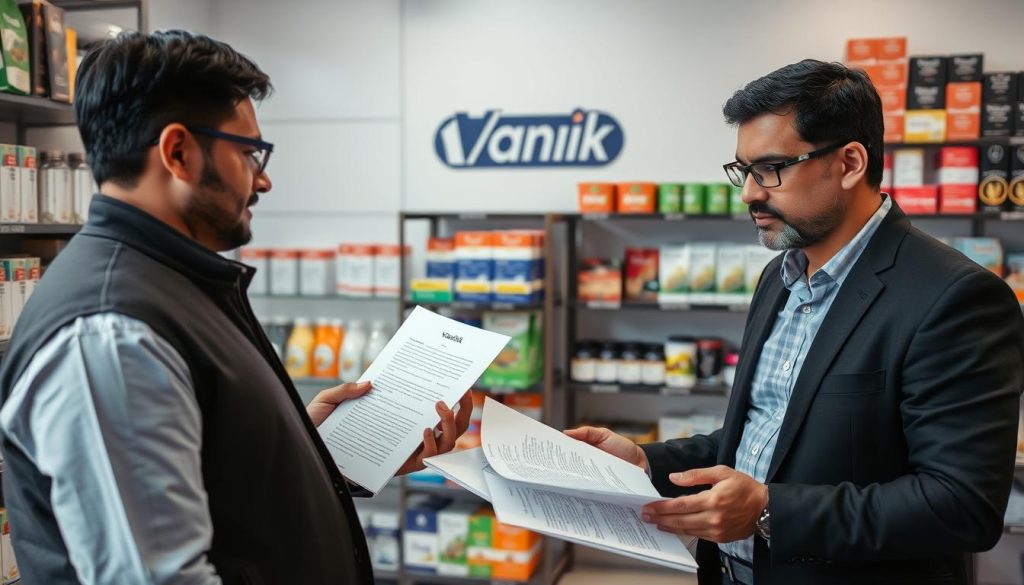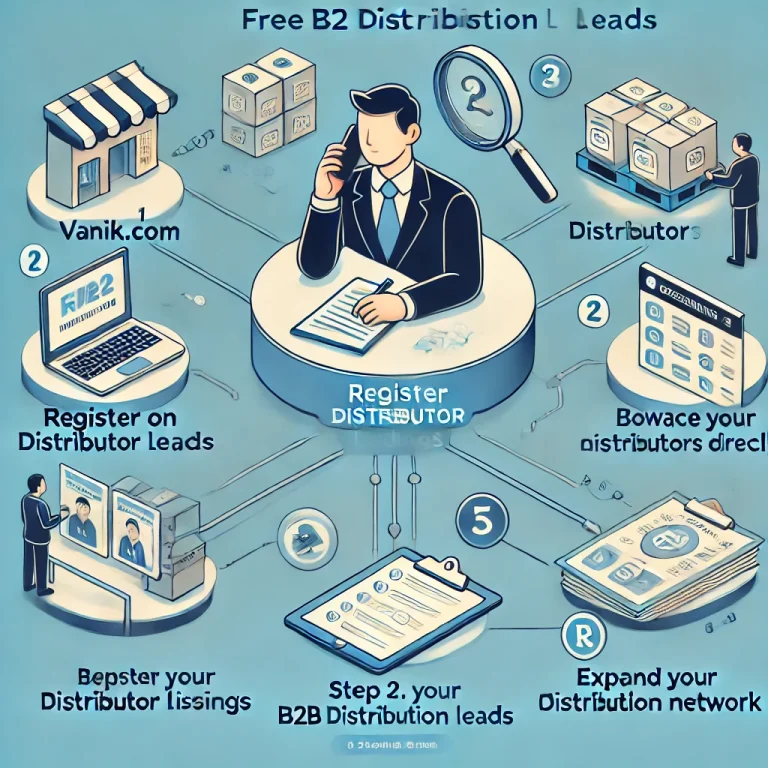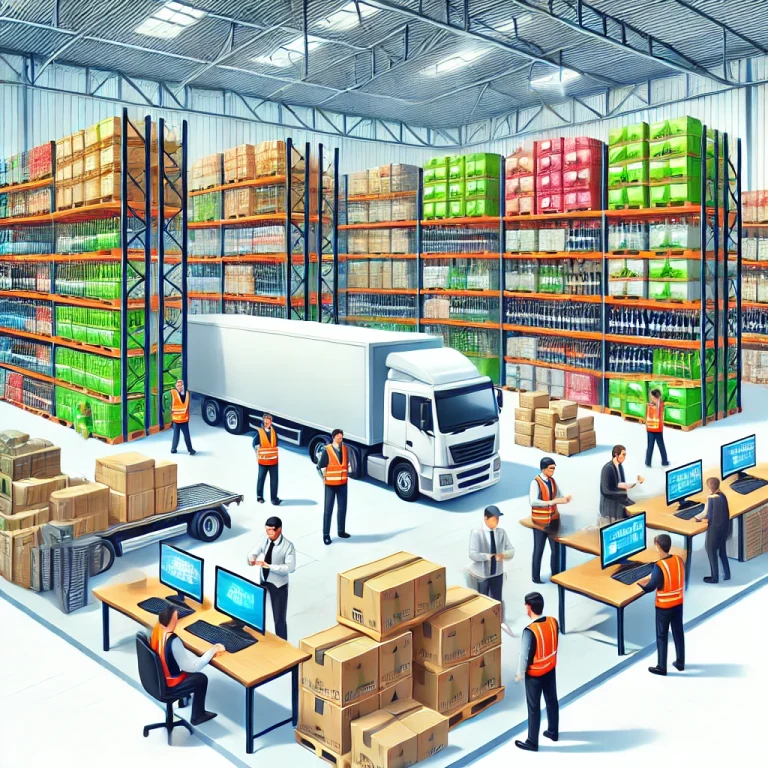Watching my dad search for reliable suppliers for our small shop made me see the value of distribution. It’s not just about moving goods. It’s about building trust, finding new chances, and helping others. This guide will show you how to be a top distributor in India for 2024.
You’ll discover what a distributor does, the various types, and how to spot market needs. We’ll talk about legal steps, planning your business, and the financial side. Plus, you’ll learn about training and support to help you succeed. By the end, you’ll know how to start as a distributor in India.
In case you want to see distributor profiles – here’s a list of 1900+ Beverage Distributors
Key Takeaways
- Understand the role and responsibilities of a distributor in India.
- Explore the different types of distributors, including retailers, wholesalers, C&F agents, and dealers.
- Learn how to assess the market demand and identify potential opportunities.
- Familiarize yourself with the legal requirements and the process of registering your distribution business.
- Develop a solid business plan to define your target market and marketing strategy.
Understanding the Role of a Distributor
As a distributor, you connect manufacturers or suppliers with retailers or end-consumers. You buy products, manage stock, and get them to your customers quickly. There are many kinds of distributors, each with their own tasks.
Defining the Responsibilities of a Distributor
The main jobs of a distributor are:
- Finding products from wholesalers, C&F agents, or manufacturers
- Keeping enough stock for retailers and dealers
- Getting products to retailers and superstockists fast
- Helping retailers and dealers with support and service
- Watching market trends and changing products as needed
Exploring the Different Types of Distributors
In the Indian market, you’ll find:
- Retailers: They buy products from distributors or wholesalers and sell to customers.
- Wholesalers: They buy lots of products from manufacturers or C&F agents and sell to retailers or dealers.
- C&F (Clearing and Forwarding) Agents: They take care of customs and moving products from manufacturers to distributors or retailers.
- Dealers: They are special retailers who buy products from distributors or wholesalers.
- Superstockists: They are big distributors who help get products to many retailers and dealers.
“The role of a distributor is to bridge the gap between manufacturers and the end-consumers, ensuring a smooth and efficient flow of products.”
Assessing the Market Demand
Before starting a distribution business, it’s key to check the market demand for your products or services. This means doing deep research, understanding who your competitors are, and finding gaps you can fill. A good market analysis helps you make smart choices and build a winning strategy.
When looking at market demand, focus on a few important things:
- Target Audience: Know who your customers are, what they want, and how they buy things.
- Competitive Analysis: Look at what others in the market are doing. See how you can stand out.
- Market Trends: Keep up with the latest trends and changes in the industry. This helps you stay ahead.
- Distribution Channels: Check out different ways to get your products to customers, like retailers, wholesalers, C&F agents, and dealers.
- Pricing and Profitability: Look at how your competitors price things. Find a balance that works for you and your customers.
By studying these areas, you’ll understand the market better. This knowledge helps you create a strong distribution plan that meets your customers’ needs and fits the industry.
“Understanding the market demand is the foundation of a successful distribution business. Thorough research and analysis will help you identify the right opportunities and minimize the risks.”
How To Become Distributor
To become a successful distributor in India, you need to do your homework. First, find potential suppliers and their products. This step is key to picking the right products to sell, based on market demand and your target audience.
Researching Potential Suppliers and Products
When looking for suppliers, check their product quality, prices, and availability. This ensures you can offer great value to your customers. Choose suppliers who deliver reliably and offer prices that fit your market.
Understanding the market is also important. You’ll meet different distributors, each with their role:
- Retailers sell directly to consumers, like in stores or online.
- Wholesalers buy in bulk and sell to retailers or businesses.
- C&F Agents handle importing and distribution logistics.
- Dealers buy and resell products to customers.
- Superstockists distribute to smaller distributors, dealers, and retailers.
Knowing about these distributors helps you find the right partners. This way, you can navigate the Indian distribution scene effectively.
| Distributor Type | Key Responsibilities | Typical Clients |
|---|---|---|
| Retailer | Selling products directly to consumers | Individual customers |
| Wholesaler | Purchasing products in bulk and reselling to retailers or other businesses | Retailers, dealers, superstockists |
| C&F Agent | Handling the logistics of importing and distributing products | Manufacturers, suppliers, retailers |
| Dealer | Purchasing products from suppliers and reselling them to customers | Individual customers, small businesses |
| Superstockist | Managing the distribution of products to various smaller distributors, dealers, and retailers | Wholesalers, dealers, retailers |
By researching suppliers and understanding different distributors, you’re ready for a successful how to become distributor journey in India.
Legal Requirements for Becoming a Distributor
If you want to be a distributor in India, you must understand the legal rules. You need to register your business and get the right licenses. This guide will help you start a legal and compliant distribution business.
Registering Your Business
The first step is to register your business. You can choose from a sole proprietorship, partnership, or private limited company. Each option has its own legal details. It’s key to pick the best one for your business and future plans.
Obtaining Necessary Licenses and Permits
- Trade License: Getting a valid trade license is essential for any distribution business in India. It lets you legally do business in your area.
- Goods and Services Tax (GST) Registration: As a distributor, you must register for GST. This is a tax system for the whole country. It helps you follow tax rules and handle tax transactions smoothly.
- Industry-Specific Certifications: You might need special certifications for certain products. For example, licenses for pharmaceuticals, food, or other regulated goods.
Following the legal steps to become a distributor in India can be tough. But with the right help and planning, you can build a strong base for your business. Make sure you meet all the registration and permit requirements. This will help you run a successful and lasting distribution business.

Building a Solid Business Plan
Making a detailed business plan is key for new distributors in India. It should outline your target market, including demographics and customer behavior. Knowing your audience well helps you create a strong marketing plan. This plan will draw in customers and set your services apart from others.
Defining Your Target Market
To make a good business plan, you need to know your target market. Look at demographics, location, and what customers need. This info helps you shape your marketing strategy to meet your customers’ needs.
- Demographic information (age, income, gender, etc.)
- Geographic region (urban, rural, specific states or cities)
- Customer needs and pain points
- Purchasing behaviors and preferences
With this data, you can adjust your application process, territories, and compensation plans. This way, you serve your ideal customers better.
Developing a Marketing Strategy
Knowing your target market, you can now make a detailed marketing plan. It should cover:
- Promotional channels (online advertising, social media, direct outreach, etc.)
- Pricing and discounting structures
- Unique value propositions to differentiate your services
- Strategies for building brand awareness and customer loyalty
A good marketing plan will help you reach and connect with your target customers. This drives growth for your distribution business.
“A well-crafted business plan is the roadmap to your distribution success. It will guide your decision-making, secure funding, and help you stand out in a competitive market.”
Distributor Application Process
Becoming a distributor in India is a detailed process. It requires careful preparation and attention to detail. The first step is to submit your application. This involves sharing information about your business, your experience, and your distribution abilities.
Submitting Your Application
The application process includes several key elements:
- Detailed business information, such as your company’s legal structure, ownership, and financial standing
- A comprehensive overview of your distribution network, including your existing customer base, inventory management processes, and logistics capabilities
- Proof of compliance with relevant legal and regulatory requirements, such as obtaining necessary licenses and permits
- Evidence of your industry experience and expertise, including any relevant certifications or awards
Preparing for the Interview Process
After reviewing your application, you might get an interview invite. This is your chance to show your distributor requirements and why you’re a good fit. Be ready to talk about:
- Your understanding of the distributor application process and the responsibilities of a distributor
- Your experience in the industry, including any successes or challenges you have faced
- Your plans for marketing and promoting the products you would be distributing
- Your financial capabilities and access to resources to support the distribution business
- Your commitment to providing excellent customer service and support
By preparing well for the application and interview, you can boost your chances of success in India’s dynamic market.
| Distributor Type | Key Responsibilities |
|---|---|
| Retailer | Selling products directly to end consumers |
| Wholesaler | Bulk distribution of products to other distributors and retailers |
| C&F Agent | Handling the clearance and forwarding of goods at ports or borders |
| Dealer | Selling products to a specific geographic area or customer segment |
| Superstockist | Maintaining large inventories and serving as a hub for other distributors |
“The application process is the gateway to becoming a successful distributor in India. It’s essential to approach it with diligence and preparation to demonstrate your qualifications and commitment to the role.”
Financial Considerations
Starting a distribution business in India needs good financial planning. You must estimate your start-up costs and look for funding options. This ensures you have enough money to start your business.
Estimating Start-up Costs
The money needed to start as a distributor is a lot. You’ll have to pay for inventory, transportation, storage, and office costs. You might also need to buy warehouse space, technology, and hire staff.
Securing Funding and Investment Options
Knowing your start-up costs helps you find funding. You can get loans from banks, apply for government grants, or find investors. Choose the best funding option for your business goals and financial needs.
| Funding Source | Advantages | Disadvantages |
|---|---|---|
| Bank Loans |
|
|
| Government Grants |
|
|
| Angel Investors |
|
|
By thinking about your financial needs and looking at funding options, you can build a solid financial base. This sets your distribution business up for success in the long run.
Distributor Training and Support
To be a successful distributor in India, you need more than just the right products. Manufacturers and suppliers offer training and support to help distributors succeed. These resources are key to developing the skills needed to excel.
Product knowledge is a crucial part of distributor training. Suppliers provide in-depth training to ensure distributors understand the products well. They learn about the features, benefits, and how to use each item.
- Product knowledge training
- Sales and marketing workshops
- Ongoing coaching and mentorship
Suppliers also offer distributor marketing support. This includes marketing materials and guidance on promotions. Distributors use these to reach and engage their customers effectively.
“The training and support provided by our suppliers has been instrumental in helping us grow our distribution business. We’ve been able to stay ahead of the curve and deliver exceptional value to our customers.”
Distributors can develop essential skills with the help of training and support. They learn sales techniques, market trends, and inventory management. This helps them thrive in the competitive Indian market.

The investment in distributor training and support is worth it. It builds a strong, knowledgeable distribution network. This network better serves suppliers and customers alike.
Establishing Distributor Territories
Working with suppliers or manufacturers means setting clear distributor territories. You might have exclusive rights to sell products in a certain area. Or, you could share the space with other distributors. Knowing the details of your distributor contracts is key to a good partnership and avoiding problems.
Exclusive Territories
Exclusive territories have big pluses. You get to be the only one selling products in a certain area. This lets you build strong ties with local businesses. You can manage your stock better and give customers a more personal service.
Non-Exclusive Territories
Non-exclusive territories, on the other hand, mean more competition. Several distributors can sell in the same area. This might make prices drop and offer more choices for shoppers. But, it also makes managing stock and keeping customers happy harder.
| Exclusive Territories | Non-Exclusive Territories |
|---|---|
| Sole distribution rights in a defined area | Multiple distributors can operate in the same region |
| Focused efforts on building relationships | More competitive market, potentially lower prices |
| Better inventory control and logistics | Increased challenges in inventory management and market share |
Choosing between exclusive and non-exclusive territories depends on your business plan and the market. Weighing the good and bad of each can help you pick the best option for your distributor territories and distributor contracts.
Conclusion
Starting your journey to become a successful distributor in India is exciting. But, it comes with challenges and chances. You might want to be a retailer, wholesaler, C&F agent, or dealer. Success depends on understanding the market, following the law, and using available resources.
Knowing your duties and the different types of distributors helps. You can then find the right products and suppliers for your audience. A good business plan, the right licenses, and funding are key to starting your business.
With hard work, the right support, and knowledge, you can succeed in India’s distribution market. Stay updated, flexible, and focused on adding value. This way, you’ll become a reliable and influential distributor, helping your business and the brands you work with thrive.
FAQ
What are the responsibilities of a distributor?
A distributor’s main job is to get products, manage stock, and send them out to customers. They work between makers or suppliers and stores or buyers.
What are the different types of distributors?
There are many kinds of distributors. These include retailers, wholesalers, C&F agents, dealers, and superstockists. Each has its own role and duties.
How do I assess the market demand for becoming a distributor?
Before you start, research the market well. Know the competition and find any gaps you can fill. A good market analysis is key to a successful strategy.
What are the steps to become a distributor in India?
To become a distributor in India, first look for suppliers and products. Then, register your business and get the right licenses. Make a solid plan and apply to be a distributor.
What are the legal requirements for becoming a distributor in India?
To be a distributor in India, register your business and get the right licenses. You’ll need a trade license and a Goods and Services Tax (GST) registration.
How do I develop a successful business plan as a distributor?
Your plan should clearly state your target market and marketing strategy. It should also have a financial plan that covers start-up costs and funding options.
What is the distributor application process like?
The application process involves sharing details about your business and experience. You’ll also have an interview to show your knowledge and commitment.
What financial considerations should I keep in mind when becoming a distributor?
Becoming a distributor costs a lot, including money for inventory, transport, and office expenses. Look for loans, grants, or partners to fund your business.
What kind of training and support do distributors receive?
Many suppliers offer training and support. This includes learning about products, sales, and marketing. These resources are crucial for success.
How are distributor territories established?
It’s key to set clear territories with suppliers. This can be exclusive or non-exclusive. Understanding your agreement helps avoid problems.
See Also
From Farm to Fashion: How Wholesale Bazaars Fuel India’s Retail Boom


